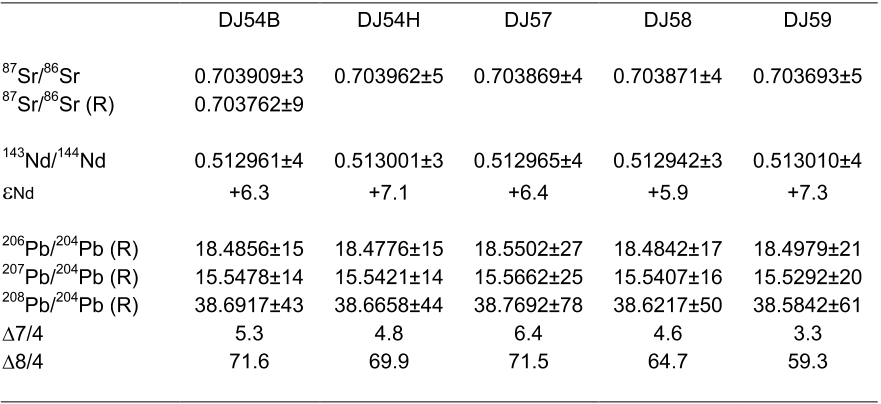A LREE-depleted component in the Afar plume; further evidence from Quaternary Djibouti basalts
Figures (8)

Table 2 (continued).4 5 
Table 2 (continued).4 5 
Table 3 Click here to download Table: Hayy_Table 3nb.doc 
Table 1. Unspiked 40K-40Ar datings of Hayyabley basalts. See text for the analytical 1 procedures. 2 3 
Table 1.5 
Table 4. Sr, Nd and Pb isotopic compositions of Hayyabley basalts (B: bulk rock; R: residue 1 after leaching). See text for the analytical procedures. Δ7/4 and Δ 8/4 denote the deviation (in 2 0/00) of 
Table 4. Sr, Nd and Pb isotopic compositions of Hayyabley basalts (B: bulk rock; R: residue 1 after leaching). See text for the analytical procedures. Δ7/4 and Δ 8/4 denote the deviation (in 2 0/00) of 
Table 3 Click here to download Table: Hayy_Table 3nb.doc
Citations
62 citations
Cites background from "A LREE-depleted component in the Af..."
...…Thirlwall et al., 2004; Kokfelt et al., 2006], the Galapagos [White et al., 1993;Hoernle et al., 2000; Blichert-Toft and White, 2001; Saal et al., 2007], Afar [Furman et al., 2006; Beccaluva et al., 2009; Daoud et al., 2010] and Hawaii [Yang et al., 2003; Frey et al., 2005; Fekiacova et al., 2007]....
[...]
46 citations
45 citations
42 citations
Cites background from "A LREE-depleted component in the Af..."
...Analogues of the Karelian Palaeoproterozoic continental MORB-type tholeiities have been recognized in the North Atlantic and Afar continental flood basalt provinces, where depleted MORB-type tholeiitic basalts are shown to have formed simultaneously with high-Ti basalts (Barrat et al., 2003; Daoud et al., 2010; S ager & Holm, 2011;Waight & Baker, 2012)....
[...]
..., 2012), and dikes (this study) compared with low-Ti tholeiites from the Faroe Islands (S ager & Holm, 2011), depleted basalts from Central East Greenland (Waight & Baker, 2012), LREE-depleted basalts from Central Afar (Barrat et al., 2003; Daoud et al., 2010), Kolbeinsey Ridge and Reykjanes Ridge basalts (PetDB), and global N-MORB (PetDB)....
[...]
...MORB-type continental tholeiitic basalts are thought to have formed as a result of melting of depleted mantle components in mantle-plume source regions (Daoud et al., 2010; S ager & Holm, 2011; Waight & Baker, 2012)....
[...]
..., 1990; Perttunen & Hanski, 2003); Fe^Ti basalts and low-Ti basalts, Faroe Islands (S ager & Holm, 2011); Fe^Ti basalts and depleted basalts, Central East Greenland (Waight & Baker, 2012); LREE-depleted basalts, Central Afar (Barrat et al., 2003; Daoud et al., 2010)....
[...]
References
76 citations
"A LREE-depleted component in the Af..." refers background in this paper
...(see 91 Defant et al., 1991, for further analytical details)....
[...]
76 citations
"A LREE-depleted component in the Af..." refers background in this paper
...This process improves the K 71 yield as well as the percentage of radiogenic argon, and removes at least some potential 72 sources of systematic error due to the presence of excess 40 Ar in olivine and feldspar 73 phenocrysts (Laughlin et al., 1994)....
[...]
75 citations
74 citations
"A LREE-depleted component in the Af..." refers background in this paper
...Hf isotope geochemistry of the Galapagos Islands....
[...]
...Petrology and geochemistry of the 778 Galapagos islands: portrait of a pathological mantle plume....
[...]
...Assimilation of plagioclase-rich gabbros from the oceanic 330 lithosphere during ascent of plume-related magmas has been proposed in the cases of offshore 331 Tadjoura Gulf basalts (Barrat et al., 1993) and Galapagos basalts (Saal et al., 2007)....
[...]
..., 2005); 51 (3) the Galapagos (White et al., 1993; Hoernle et al., 2000; Blichert-Toft and White, 2001; 52 Saal et al., 2007); and (4) the Kerguelen Archipelago (Doucet et al....
[...]
...The role of lithospheric gabbros on the composition of Galapagos lavas....
[...]
72 citations
"A LREE-depleted component in the Af..." refers result in this paper
...Alternatively, LREE 424 depletion could be due to a previous melting event affecting the plume materials, as proposed 425 by Thirlwall et al. (2004) for their ID2 (or RRD2) depleted component of the Icelandic plume....
[...]
...The Ba, Sr and Eu positive anomalies in the Hayyabley basalts 304 305 The origin of Ba, Sr and Eu positive anomalies in LREE-depleted basalts has been 306 previously investigated in the cases of some Icelandic basalts (e.g., Kokfelt et al., 2006 and 307 references therein) and of the Manda Hararo basalts (Barrat et al., 2003)....
[...]
...Chauvel and Hémond (2000), Skovgaard et al. (2001), and Kokfelt et al. (2006) 371 have suggested that the sources of Icelandic lavas contained an old recycled oceanic 372 lithosphere component and that melting of the gabbroic portion of this lithosphere led to the 373 formation of basalts that exhibit large positive Ba, Sr and Eu anomalies....
[...]
...In addition, the Nb/Y and Zr/Y ratios (0.11-0.15 and 2.20-2.57, 245 respectively, Table 2) of Hayyabley basalts are such that these lavas plot within the field of 246 Icelandic plume basalts, and well above the N-MORB field, in Fitton et al.‟s (1997, 2003) 247 rectangular plot (not shown)....
[...]
...Similar conclusions have been reached for the Hawaiian 418 (Frey et al., 2005) and Icelandic (Thirlwall, 1995; Kerr et al., 1995; Fitton et al., 1997; 419 Chauvel and Hémond, 2000; Thirlwall et al., 2004; Skovgaard et al., 2001; Kokfelt et al., 420 2006) plumes....
[...]